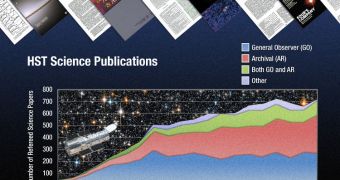Officials at NASA and the European Space Agency (ESA) are ecstatic to note that the Hubble Space Telescope has just been used in a 10,000th refereed science paper, making the now-legal observatory the most widely-used astronomy mission ever.
While Hubble is a joint endeavor between NASA and ESA, study hours can be obtained on it by researchers from all over the world. In its 21-year history, the instrument has been used by experts from more than 35 countries.
Astronomers in the United States naturally published most of the paper referring Hubble data, but they are followed closely by colleagues in the United Kingdom, Germany, Italy, France and Spain.
What is even more remarkable is the sheer number of fields of research in which Hubble data could be applied. In this new light, the fact that NASA conducted not one, but five repair missions to bring the telescope up-to-date can be recognized as tremendous foresight.
However, there are certain areas for which the observatory is better suited. For example, most experts use it to look for distant supernova explosions, in hopes that this will help them get some insight into the nature of dark energy.
Others use the telescope to determine Hubble's constant, which deals with establishing the precise rate at which the Universe is currently expanding. Another primary use for Hubble is establishing how black holes and their host galaxies influence each other in terms of mass.
Many research teams used it to conduct and expand upon the Hubble Deep Field, a study of the early Universe trying to figure out what the first galaxies looked and behaved like while they formed.
“The first science paper from a Hubble observation was submitted on October 1,1990, by Tod Lauer of the National Optical Astronomy Observatory in Tucson, Ariz. This paper reported observations of the environment around a suspected black hole in the core of galaxy NGC 7457,” NASA reports.
“The 10,000th paper […] reports on the identification of the faintest supernova ever associated with a long-duration gamma-ray burst – an intense gusher of high-energy radiation following the death of a star,” the agency adds in a press release.
In addition to its stand-alone studies, the Hubble is also often used in conjunction with other telescopes. Together, these larger observatories use multiple wavelengths to cast light on objects that could never have been observed otherwise – such as stellar nurseries, black holes and forming stars.
“The number of science papers written based on Hubble archival data has increased to the point where it has eclipsed the number of papers resulting from new observations. Hubble's archive contains data from over 1 million exposures,” the NASA statement concludes.

 14 DAY TRIAL //
14 DAY TRIAL //